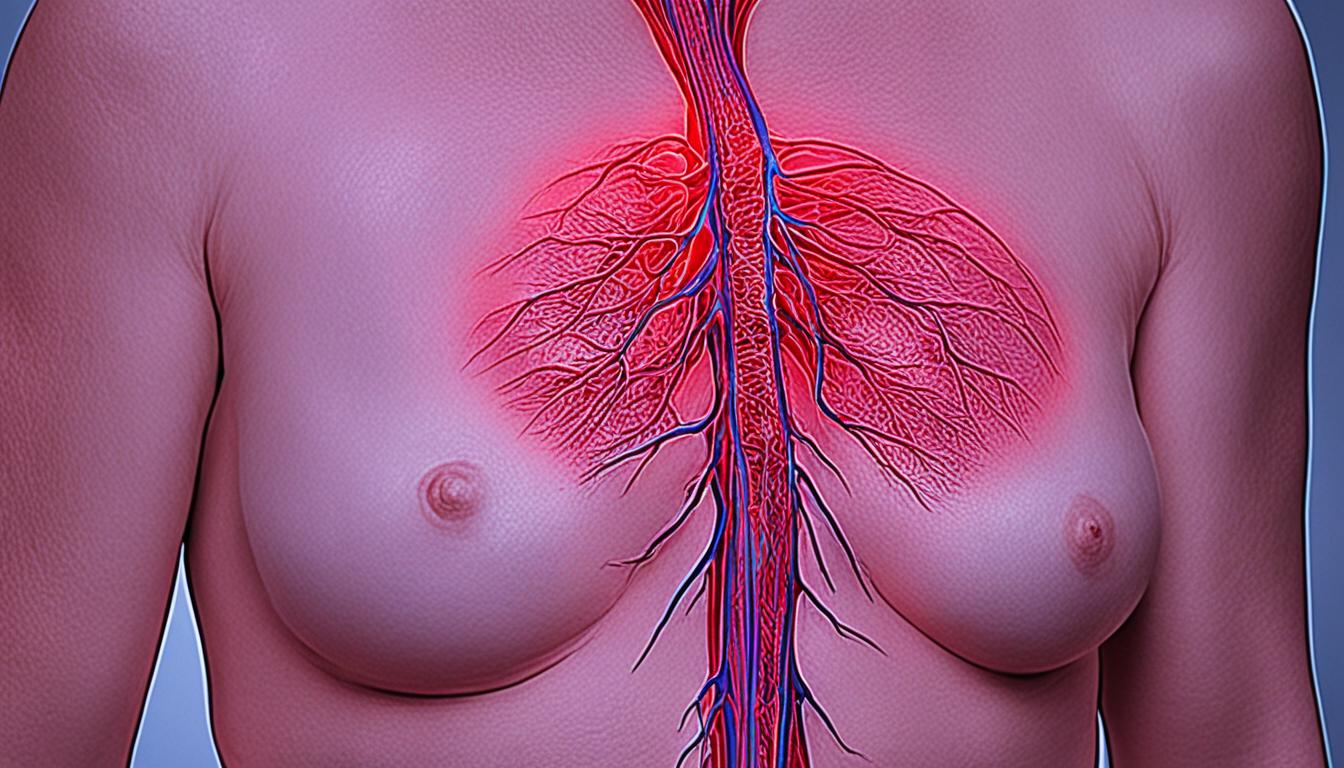Mastalgia, also known as breast pain or breast tenderness, happens to many people. It brings discomfort in the breasts and nipples. There are two main types: cyclical and noncyclical. Cyclical pain comes with hormonal shifts and usually appears during the menstrual cycle. Noncyclical pain can come from many things, like trauma or muscle pain.
For cyclical pain, you can use warm compresses or take painkillers. Changing your lifestyle, such as drinking less caffeine or getting more vitamin E, might also help. Sometimes doctors suggest things like birth control to help. Pregnant or breastfeeding people might feel breast pain too. They can use proper support and methods like applying warm or cold compresses. If pain comes from an infection, such as mastitis, you need to see a doctor. Fibrocystic breast disease, even though it’s not dangerous, can still cause discomfort. This can also be helped with lifestyle changes and pain medicine.
Often, breast pain is not a sign of cancer. But it’s important to see a doctor if the pain is strong, ongoing, or comes with other worrying signs.
Stem cell therapy has become a hopeful treatment for many illnesses, including mastalgia. It works by repairing damaged tissues and easing swelling. In Thailand, this therapy is changing how mastalgia is managed. It’s providing new pain-relief options and better lives for patients.
Key Takeaways:
- Mastalgia, or breast pain, can be cyclical or noncyclical.
- Cyclical breast pain is linked to hormonal changes, while noncyclical breast pain can be caused by trauma or joint and muscle pain.
- Lifestyle changes, medication, and proper breast support can help alleviate breast pain.
- Seek medical attention if the pain is severe, persistent, or accompanied by concerning symptoms.
- Stem cell therapy is a promising treatment option for mastalgia.
Understanding the Causes of Mastalgia
Mastalgia, or breast pain, has many causes. Knowing these reasons is vital for proper diagnosis and treatment.
Hormonal Shifts
Hormonal changes affect mastalgia, especially with cyclical pain. This pain occurs before and during the menstrual cycle. It may also be felt in the underarms.
This discomfort is due to changes in hormones. It causes sore breasts, nipple pain, and chest aches.
Breast Infections
Factors like mastitis or yeast infections can make breasts hurt. These need medical help. They result in soreness, tenderness, and nipple pain.
It’s critical to treat the infection to manage mastalgia properly.
Pregnancy and Breastfeeding
During pregnancy and breastfeeding, breasts change a lot. These changes can lead to pain and heaviness in the breasts. Supporting the breasts properly and using cold or warm compresses can help ease the discomfort.
Trauma and Arthritic Pain
If there’s chest trauma or injuries, it can lead to breast pain. Arthritis around the chest can also be a cause.
Dealing with any trauma or pain from arthritis can reduce breast discomfort.
Fibrocystic Breast Disease
Fibrocystic breast disease causes changes in breast tissue. This can lead to breast soreness and chest pain. Though not dangerous, it can affect daily life.
Lifestyle changes and pain relievers can help manage the pain.
Most mastalgia cases are not linked to breast cancer. However, if pain is severe or doesn’t go away, see a doctor. Knowing what’s causing the pain is key to finding the right treatment.
In the next part, we will look into diagnosing mastalgia and the treatments available. Our aim is to help people feel better and lower their breast pain for a better quality of life.
Diagnosis and Treatment Options for Mastalgia
Diagnosing mastalgia includes a thorough checkup and tests like mammograms. Doctors aim to rule out diseases like cancer.
The way to treat mastalgia depends on its type. For monthly pain, changing lifestyle habits can help. This may involve less caffeine, more vitamin E, and a diet low in fat. Pain meds are also an option. Hormone therapy could be used if needed.
Non-periodic pain focuses on its root cause. Help comes through physical therapy or muscle-targeted exercises. This tackles pain related to joints or muscles.
Breast pain is common during pregnancy and nursing. Hormones and body changes cause this. A good bra and warm or cold packs can ease discomfort.
Breast infections are another cause of mastalgia. Doctors usually give antibiotics to fight off these infections.
Fibrocystic breast disease can bring about discomfort. Lifestyle changes might be suggested. If pain persists, the fluid from cysts can be drained for relief.
| Diagnosis and Treatment Options for Mastalgia | Summary |
|---|---|
| Diagnosis |
|
| Treatment Options |
|
Stem cell therapy is a new path in treating mastalgia. It uses stem cells to heal and reduce swelling. This is becoming more common in Thailand, offering more hope for better pain and life quality.
Conclusion
Mastalgia, or breast pain, can really impact how someone lives. It’s key to know what causes this to find the right treatment. Breast pain is usually not a sign of cancer. But, if the pain is bad all the time or you notice something else odd, see a doctor.
There are many ways to treat mastalgia. You can change your lifestyle or take meds. For example, less caffeine, more vitamin E, and a low-fat diet can ease cyclic pain. Things like ibuprofen can help too, as well as treatments that change your hormones.
In Thailand, stem cell therapy is changing how we treat mastalgia. This approach helps fix tissue and lowers swelling. It’s offering hope to many for better pain management and healing. Today, there are many new ways to diagnose and treat mastalgia. This means more people can find relief and feel better.

